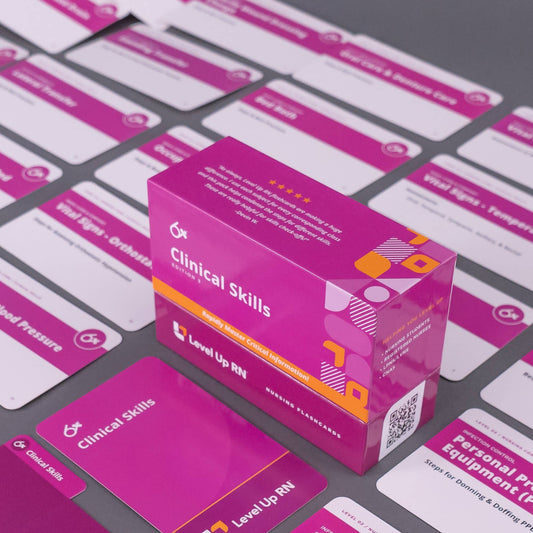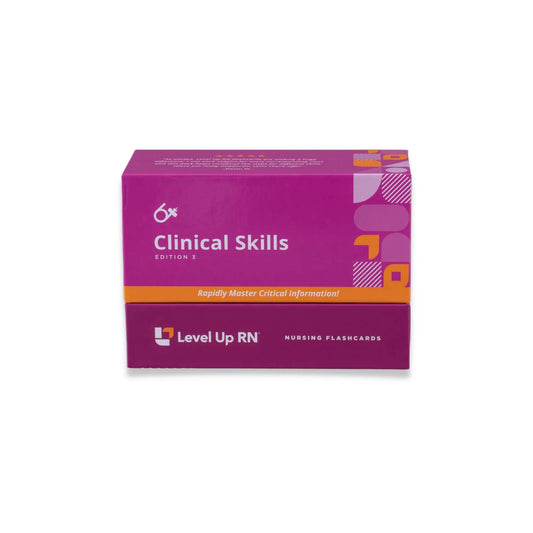Clinical Skills - Indwelling Urinary Catheter Insertion (Female)
Updated: Ellis ParkerHow to insert and remove an indwelling urinary catheter on a patient with a vagina. After the demonstration, additional information on the balloon, its size, its purpose, and how to obtain a urine sample from a catheterized patient.
Full Transcript: Clinical Skills - Indwelling Urinary Catheter Insertion (Female)
Full Transcript: Clinical Skills - Indwelling Urinary Catheter Insertion (Female)
Hi, I'm Ellis with LevelUpRN. In this video, I'll be demonstrating how to insert an indwelling urinary catheter on a patient that has a vagina. I'll be following the steps that we included in our clinical nursing skills deck. So if you have the cards, go ahead and grab them. If you don't have the cards, you can grab the deck at leveluprn.com so you can follow along with me.
After the demonstration, come on back here because I've got a few other things I'd like to show you. To prepare to insert a catheter on a female patient, I need to have positioned them in a dorsal recumbent position which just means to spread their knees open, can kind of be called a frog-leg position, so that we have access to their urethra. And then I'm going to go ahead and open my kit and prepare my sterile field.
So it's fairly common for people to use this outside bag as just like a garbage can. So I like to set it up in case I need it. And I'm going to set it up right here. I'm going to position my box so that when I open the tabs, it allows it to sit at an angle here. So I'll take this first tab, open it away from me, open the side tabs, just pinching that outside portion, not touching the inside of my sterile kit. All right. And then these stickers are available to put on the catheter bag itself, so we'll get to that later. And then we've got our drape that goes down on the bed in between the patient's legs. So I'm going to touch just the outside portion, which is the shiny side, so place that under my patient. And then these kits come with sterile gloves, but I'm going to go ahead and move these because I like to wear a certain size.
So I've gone ahead and just grabbed my size of sterile gloves.
I'm going to put them on the edge of my table because I don't want to be working with these sterile gloves on top of my sterile field. And this is an error I see students do a lot. They'll open the sterile package over their sterile field or have it right here on the edge, and that means that I'm already contaminating that field. So I like to, like I said, position this initial sterile field at that angle so when I open it, I have left space here for my sterile glove packaging. So I've got my sterile gloves. I'm going to pick up my dominant cuff with my non-dominant hand. And then using my fingers of my dominant hand, I'm going to scoop up my non-dominant cuff, keeping my thumb out, and roll it on, again, making sure that I actually can't fix this rolling part right here because it's already touched my skin. So that's just how they go on. So then I can move this. I can touch it from the center and discard it in the trash without dropping my hands below my waist.
All right. So now I've got my fenestrated drape, and I can place this over my patient's labia. Yep, should have moved that a little bit more. And then I'm going to prepare my kit itself. So I'm going to break the rules really quick here just to grab these. They're simulated swab sticks because I can't put iodine of my patient. So we'll just pretend that came in my box. Those are the swabs I'll be using. So my kit has swabs or sometimes they have alcohol and cotton balls. My kit will have lubricant that I'll go ahead and open and squeeze some out into the tray. My kit will have a syringe with normal saline in it. Then I'm going to connect to my catheter tubing so that I can inflate that balloon. And then most of these kits also come with a sterile cup. So if I needed to get a sterile specimen, I have the ability to do so. But I'm going to just put that back for now.
All right. So I'm going to take the cover off my catheter, and I'm doing this pretty carefully, making sure the catheter falls gently into the box. If I just flicked this cover off like that, the catheter tip could just fly out of the box and hit something else. And then I'm going to go ahead and put the catheter into the lubricant, make sure it's generously lubricated for insertion, and then I'm going to go ahead and move this box here to facilitate the insertion. All right. Now I'm going to prepare my patient's urethra. So I'm going to get my swab sticks ready. And once I touch her with my non-dominant hand, this hand is no longer sterile. So I have to make sure that I've already prepared everything how I want to insert because I won't have the use of my left hand anymore.
So I'm going to take my left hand and spread open the labia. I'm going to swipe down one side and discard, get a second swab, swipe down the other side and discard, and take the final swab and swipe down the center. And I'm going to leave my left hand here. I need to keep her labia separated. If I were to let go and allow the labia to close over the urethra, I might be reintroducing bacteria over the urethra, and I would technically have to start that process over again. So I'm going to leave my hand here keeping her labia spread. I'm going to pick up the end of my catheter and insert it into her urethra. I'm going to ask my patient to bear down, please.
All right, bear down. I'm going to keep entering. Once I see your inflow in the tubing there, I'll insert another two to three inches for my females. All right. I'm going to stop. I'm going to pinch that with my left hand so it doesn't accidentally shoot back out because sometimes the pressure can make the catheter tubing exit. I'm going to inflate the balloon. So steadily inflating the balloon. All right. I can now let go. I can disconnect my syringe. And then I do want to grab this tubing and pull it down until I feel a slight resistance, and just a gentle tug so that that balloon settles into the opening of the bladder into the urethra so that no urine can go around the balloon and leak around the tubing. So I'll just settle that right there. And then once that's done, I can go ahead and secure the bag to the leg and make sure my patient is positioned safely. And that's how you insert an indwelling catheter on a female patient.
Once it's been ordered for my patient's catheter to be removed, I simply reposition my patient, and I come in. I can take the sticker or anchor that's keeping the catheter to their leg. I simply find that balloon port and get an empty 10cc syringe or 10-milliliter syringe. I plug that in, withdraw all the fluid that we put in so that I don't cause any trauma to the urethra when I'm pulling this out. Sometimes you may want to put a Chux pad or a waterproof pad underneath the patient because this action might cause some urine to leak out. But I simply withdraw all the liquid from the balloon, and I pull the catheter out, and then I might provide some perinatal care if needed. And that's how you remove the catheter.
I wanted to take this opportunity to demonstrate a couple of things about catheters that you may or may not get to see before you go into practice. The first thing I want to show you is the balloon. So you know now that I will attach my balloon syringe and inflate the balloon after, of course, it's already been inserted into my patient. So you may not have been able to see that this is what that looks like. That's pretty big. So I just really wanted to give you guys a visual representation that this is what's inside your patient. This is why we tell you to gently tug on the balloon because it's sitting at that opening into the urethra, and we want to be able to settle it so that urine doesn't leak around it. This is also why it's really important to make sure that the tubing is secured to your patient's leg so that this doesn't accidentally get pulled through their urethra intact. You can imagine that that would cause extensive damage. It also, hopefully, encourages you to make sure that you withdraw everything that was put into the balloon out of the balloon before you withdraw it from your patient so that you don't do any damage to your patient's urethra.
The other thing I wanted to point out is that most catheters come with a Luer Lock Port now. Occasionally, you'll still find ones that have a rubber stopper here that you would still need to use a needle to get a sample, but most of them are Luer Lock. We have these in our cards, and I just wanted to explain really quickly that to obtain a urinary sample, I would likely clamp my tubing so that the urine can't proceed into the bag. Once this area has urine in it, I would then get a 10-milliliter Luer Lock Syringe, clean my port site, attach my Luer Lock Syringe. That's hard to do without holding it. And from there, I can withdraw my urine sample. I would not get urine from the bag if this is a pre-existing indwelling urinary catheter.



1 comment
I want to know more on the insertion of the indwelling catheter